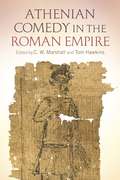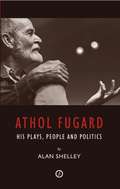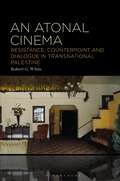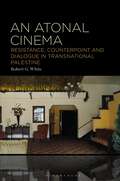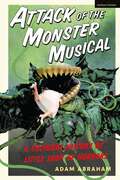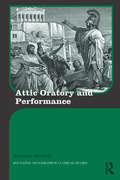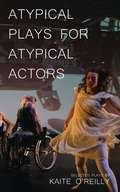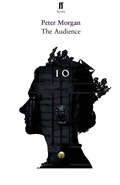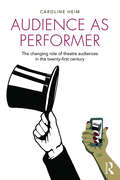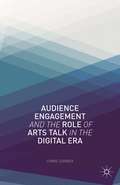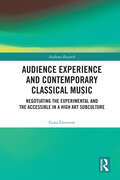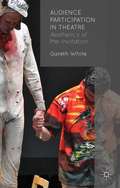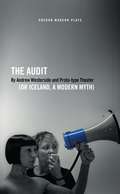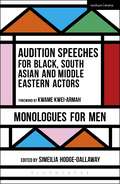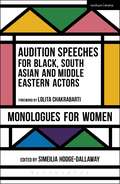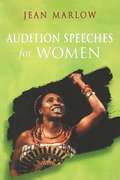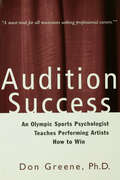- Table View
- List View
Athenian Comedy in the Roman Empire
by C. W. Marshall Tom HawkinsAthenian comedy is firmly entrenched in the classical canon, but imperial authors debated, dissected and redirected comic texts, plots and language of Aristophanes, Menander, and their rivals in ways that reflect the non-Athenocentric, pan-Mediterranean performance culture of the imperial era. Although the reception of tragedy beyond its own contemporary era has been studied, the legacy of Athenian comedy in the Roman world is less well understood.This volume offers the first expansive treatment of the reception of Athenian comedy in the Roman Empire. These engaged and engaging studies examine the lasting impact of classical Athenian comic drama. Demonstrating a variety of methodologies and scholarly perspectives, sources discussed include papyri, mosaics, stage history, epigraphy and a broad range of literature such as dramatic works in Latin and Greek, including verse satire, essays, and epistolary fiction.
Athol Fugard: His Plays, People And Politics
by Alan ShelleyA playwright whose work is appreciated on a global scale, Athol Fugard’s plays have done more to document and provide a cultural commentary on Apartheid-era South Africa than any other writer in the last century. Using mostly migrant workers and township dwellers, and staging guerrilla-raid productions in black areas, Fugard frequently came into conflict with the government, forcing him to take his work overseas. Consequently, powerful plays such as The Blood Knot, Sizwe Banzi is Dead, and Master Harold... and the boys came to broadcast the inequities of the Apartheid-era to the world. Fugard’s work retains an insistent influence, and is studied and performed the world over.Alan Shelley’s study is an accessible but profound analysis of the man, his work and its influence, the social injustices that drive him, and the lives of those who people his remarkable plays.
An Atonal Cinema: Resistance, Counterpoint and Dialogue in Transnational Palestine
by Robert G. WhiteThis is a book about Palestinians elsewhere and Palestinian elsewheres. Articulating an ambiguous right to remain out-of-place as a spatialized response to the fossilized present, the films and filmmakers in this book examine Palestine, as a place and idea, from the dissonance of exile. An Atonal Cinema: Resistance, Counterpoint and Dialogue in Transnational Palestine theorizes a transnational consciousness within contemporary Palestinian cinema as one which articulates an 'atonal' cinema, utilizing contrapuntal dialogue as a mode of resistance with which to respond critically to the 'place-myth' of Palestine in films produced within Palestine but without Palestinians. Drawing on a genealogy of Edward Said's atonal thinking of counterpoint, I argue that the films in this book display a 'double-consciousness', through which Palestine is simultaneously elided and re-inscribed in a contrapuntal dialogue between the 'here' of its contemporary reality and the 'elsewhere' of its historical image. An Atonal Cinema's radical approach includes cinematic texts from Europe, South America and Israel in its corpus, which have both triggered and been shaped by critical responses in contemporary Palestinian Cinema. Drawing on both literature and cinema, An Atonal Cinema draws on the work of Edward Said, Mahmoud Darwish, Jean Genet and Carlo Levi. Films by Pier Paolo Pasolini, Jean-Luc Godard, Menahem Golan and Miguel Littín are read contrapuntally through contemporary responses from Ayreen Anastas, Basma Alsharif, Mohanad Yaqubi, Elia Suleiman and Kamal Aljafari.
An Atonal Cinema: Resistance, Counterpoint and Dialogue in Transnational Palestine
by Robert G. WhiteThis is a book about Palestinians elsewhere and Palestinian elsewheres. Articulating an ambiguous right to remain out-of-place as a spatialized response to the fossilized present, the films and filmmakers in this book examine Palestine, as a place and idea, from the dissonance of exile. An Atonal Cinema: Resistance, Counterpoint and Dialogue in Transnational Palestine theorizes a transnational consciousness within contemporary Palestinian cinema as one which articulates an 'atonal' cinema, utilizing contrapuntal dialogue as a mode of resistance with which to respond critically to the 'place-myth' of Palestine in films produced within Palestine but without Palestinians. Drawing on a genealogy of Edward Said's atonal thinking of counterpoint, I argue that the films in this book display a 'double-consciousness', through which Palestine is simultaneously elided and re-inscribed in a contrapuntal dialogue between the 'here' of its contemporary reality and the 'elsewhere' of its historical image. An Atonal Cinema's radical approach includes cinematic texts from Europe, South America and Israel in its corpus, which have both triggered and been shaped by critical responses in contemporary Palestinian Cinema. Drawing on both literature and cinema, An Atonal Cinema draws on the work of Edward Said, Mahmoud Darwish, Jean Genet and Carlo Levi. Films by Pier Paolo Pasolini, Jean-Luc Godard, Menahem Golan and Miguel Littín are read contrapuntally through contemporary responses from Ayreen Anastas, Basma Alsharif, Mohanad Yaqubi, Elia Suleiman and Kamal Aljafari.
Attack of the Monster Musical: A Cultural History of Little Shop of Horrors
by Adam AbrahamHow many hit musicals are based on films that were shot in two days at a budget of $30,000? The answer is one: Little Shop of Horrors. Roger Corman's monster movie opened in 1960, played the midnight circuit, and then disappeared from view. Two decades later, Little Shop of Horrors opened Off-Broadway and became a surprise success. Attack of the Monster Musical: A Cultural History of Little Shop of Horrors chronicles this unlikely phenomenon. The Faustian tale of Seymour and his man-eating plant transcended its humble origins to become a global phenomenon, launching a popular film adaptation and productions all around the world. This timely and authoritative book looks at the creation of the musical and its place in the contemporary musical theatre canon. Examining its afterlives and wider cultural context, the book asks the question why this unlikely combination of blood, annihilation, and catchy tunes has resonated with audiences from the 1980s to the present. At the core of this in-depth study is the collaboration between the show's creators, Howard Ashman and Alan Menken. Told through archival research and eyewitness accounts, this is the first book to make extensive use of Ashman's personal papers, offering a unique and inspiring study of one of musical theatre's greatest talents.
Attic Oratory and Performance (Routledge Monographs in Classical Studies)
by Andreas SerafimIn a society where public speech was integral to the decision-making process, and where all affairs pertaining to the community were the subject of democratic debate, the communication between the speaker and his audience in the public forum, whether the law-court or the Assembly, cannot be separated from the notion of performance. Attic Oratory and Performance seeks to make modern Performance Studies productive for, and so make a significant contribution to, the understanding of Greek oratory. Although quite a lot of ink has been spilt over the performance dimension of oratory, the focus of nearly all of the scholarship in this area has been relatively narrow, understanding performance as only encompassing 'delivery' – the use of gestures and vocal ploys – and the convergences and divergences between oratory and theatre. Serafim seeks to move beyond this relatively narrow focus to offer a holistic perspective on performance and oratory. Using examples from selected forensic speeches, in particular four interconnected speeches by Aeschines (2, 3) and Demosthenes (18, 19), he argues that oratorical performance encompassed subtle communication between the speaker and the audience beyond mere delivery, and that the surviving texts offer numerous glimpses of the performative dimension of these speeches, and their links to contemporary theatre.
Attic Oratory and Performance (Routledge Monographs in Classical Studies)
by Andreas SerafimIn a society where public speech was integral to the decision-making process, and where all affairs pertaining to the community were the subject of democratic debate, the communication between the speaker and his audience in the public forum, whether the law-court or the Assembly, cannot be separated from the notion of performance. Attic Oratory and Performance seeks to make modern Performance Studies productive for, and so make a significant contribution to, the understanding of Greek oratory. Although quite a lot of ink has been spilt over the performance dimension of oratory, the focus of nearly all of the scholarship in this area has been relatively narrow, understanding performance as only encompassing 'delivery' – the use of gestures and vocal ploys – and the convergences and divergences between oratory and theatre. Serafim seeks to move beyond this relatively narrow focus to offer a holistic perspective on performance and oratory. Using examples from selected forensic speeches, in particular four interconnected speeches by Aeschines (2, 3) and Demosthenes (18, 19), he argues that oratorical performance encompassed subtle communication between the speaker and the audience beyond mere delivery, and that the surviving texts offer numerous glimpses of the performative dimension of these speeches, and their links to contemporary theatre.
Atypical Plays for Atypical Actors: Selected Plays by Kaite O'Reilly (Oberon Modern Playwrights)
by Kaite O'ReillyAtypical Plays For Atypical Actors is the first of its kind: a collection of dramas which redefines the notion of normalcy and extends the range of what it is to be human. From monologues, to performance texts, to realist plays, these involving and subversive pieces explore disability as a portal to new experience. 'Includes the plays: peeling, The Almond and the Seahorse, In Water I’m Weightless, the 9 Fridas and Cosy.
The Audience
by Peter MorganFor sixty years Elizabeth II has met each of her twelve prime ministers in a weekly audience at Buckingham Palace, a meeting like no other in British public life. It is private. Both parties have an unspoken agreement never to repeat what is said. Not even to their spouses.The Audience breaks this contract of silence. It imagines a series of pivotal meetings between the Downing Street incumbents and their Queen. From Churchill to Cameron, each prime minister has used these private conversations as a sounding board and a confessional - sometimes intimate, sometimes explosive.From young mother to grandmother, these private audiences chart the arc of the second Elizabethan Age. Politicians come and go through the revolving door of electoral politics, while she remains constant, waiting to welcome her next prime minister.The Audience by Peter Morgan premiered at the Gielgud Theatre, London, in March 2013.
Audience as Performer: The changing role of theatre audiences in the twenty-first century
by Caroline Heim'Actors always talk about what the audience does. I don’t understand, we are just sitting here.' Audience as Performer proposes that in the theatre, there are two troupes of performers: the actors and the audience. Although academics have scrutinised how audiences respond, make meaning and co-create while watching a performance, little research has considered the behaviour of the theatre audience as a performance in and of itself. This insightful book describes how an audience performs through its myriad gestural, vocal and paralingual actions, and considers the following questions: If the audience are performers, who are their audiences? How have audiences’ roles changed throughout history? How do talkbacks and technology influence the audience’s role as critics? What influence does the audience have on the creation of community in theatre? How can the audience function as both consumer and co-creator? Drawing from over 140 interviews with audience members, actors and ushers in the UK, USA and Austrialia, Heim reveals the lived experience of audience members at the theatrical event. It is a fresh reading of mainstream audiences’ activities, bringing their voices to the fore and exploring their emerging new roles in the theatre of the Twenty-First Century.
Audience as Performer: The changing role of theatre audiences in the twenty-first century
by Caroline Heim'Actors always talk about what the audience does. I don’t understand, we are just sitting here.' Audience as Performer proposes that in the theatre, there are two troupes of performers: the actors and the audience. Although academics have scrutinised how audiences respond, make meaning and co-create while watching a performance, little research has considered the behaviour of the theatre audience as a performance in and of itself. This insightful book describes how an audience performs through its myriad gestural, vocal and paralingual actions, and considers the following questions: If the audience are performers, who are their audiences? How have audiences’ roles changed throughout history? How do talkbacks and technology influence the audience’s role as critics? What influence does the audience have on the creation of community in theatre? How can the audience function as both consumer and co-creator? Drawing from over 140 interviews with audience members, actors and ushers in the UK, USA and Austrialia, Heim reveals the lived experience of audience members at the theatrical event. It is a fresh reading of mainstream audiences’ activities, bringing their voices to the fore and exploring their emerging new roles in the theatre of the Twenty-First Century.
Audience Engagement and the Role of Arts Talk in the Digital Era
by L. ConnerThis book offers readers an understanding of the theoretical framework for the concept of Arts Talk, provides historical background and a review of current thinking about the interpretive process, and, most importantly, provides ideas and insights into building audience-centered and audience-powered conversations about the arts.
Audience Experience and Contemporary Classical Music: Negotiating the Experimental and the Accessible in a High Art Subculture (Audience Research)
by Gina EmersonThis book responds to recent debates on cultural participation and the relevance of music composed today with the first large-scale audience experience study on contemporary classical music. Through analysing how existing audience members experience live contemporary classical music, this book seeks to make data-informed contributions to future discussions on audience diversity and accessibility. The author takes a multidimensional view of audience experience, looking at how sociodemographic factors and the frames of social context and concert format shape aesthetic responses and experiences in the concert hall. The book presents quantitative and qualitative audience data collected at twelve concerts in ten different European countries, analysing general trends alongside case studies. It also offers the first large-scale comparisons between the concert experiences and tastes of contemporary classical and classical music audiences. Contemporary classical music is critically discussed as a ‘high art subculture’ rife with contradictions and conflicts around its cultural value. This book sheds light on how audiences negotiate the tensions between experimentalism and accessibility that currently define this genre. It provides insights relevant to academics from audience research in the performing arts and from musicology, as well as to institutions, practitioners and artists.
Audience Experience and Contemporary Classical Music: Negotiating the Experimental and the Accessible in a High Art Subculture (Audience Research)
by Gina EmersonThis book responds to recent debates on cultural participation and the relevance of music composed today with the first large-scale audience experience study on contemporary classical music. Through analysing how existing audience members experience live contemporary classical music, this book seeks to make data-informed contributions to future discussions on audience diversity and accessibility. The author takes a multidimensional view of audience experience, looking at how sociodemographic factors and the frames of social context and concert format shape aesthetic responses and experiences in the concert hall. The book presents quantitative and qualitative audience data collected at twelve concerts in ten different European countries, analysing general trends alongside case studies. It also offers the first large-scale comparisons between the concert experiences and tastes of contemporary classical and classical music audiences. Contemporary classical music is critically discussed as a ‘high art subculture’ rife with contradictions and conflicts around its cultural value. This book sheds light on how audiences negotiate the tensions between experimentalism and accessibility that currently define this genre. It provides insights relevant to academics from audience research in the performing arts and from musicology, as well as to institutions, practitioners and artists.
Audience Participation: Essays on Inclusion in Performance (Contributions in Drama and Theatre Studies)
by Susan KattwinkelScholarly work on the impact of an active audience on theatrical and dance performance is a relatively new phenomenon, one that until now has manifested itself largely in the form of scattered dialogue on the subject. Audience Participation: Essays on Inclusion in Performance serves as a corrective to this. While the passive audience has long been acknowledged in works on response theory and audience studies for its contribution to the performance event, performance styles that use the audience as an active contributing creative force have been appended to the studies as merely variations on a theme.This anthology brings together essays on direct audience participation in the work of fourteen widely varied theatrical and dance artists, covering performance genres of the past and present, popular entertainment and high art. Its comprehensiveness and uniqueness make it an important contribution to the literature on theater and its many forms and facets.
Audience Participation in Theatre: Aesthetics of the Invitation
by G. WhiteThis book asks that we consider the practices that facilitate audience participation on equal terms with other elements of the theatre maker's art; it offers a theoretical basis for this new approach, illustrated by examples from diverse participatory performances.
The Audit (Oberon Modern Plays)
by Andrew Westerside Proto-Type TheaterThere’s a shadow coming, across the sea. Long and terrifying. The vultures are circling, the wolves are howling… how can we weather this storm?The global economy is a mess. The crash has landed, the tide’s swept out, and it’s taken our hope with it. There’s less in our pockets and more to be spent. The rich have got richer, the middle’s squeezed tight, and the poor are being dragged ever downwards.With the true value of money and the human cost of greed firmly in their sights, Proto-type Theater tell the story of how, in the aftermath of the 2008 economic crash, the nation of Iceland raised their voices in protest and railed against the currents.Using original text, performance, film, music and animation, The Audit is about finding strength, overcoming a world designed to keep us docile, and how collective power can move a mountain – even if only a little.
Audition Speeches for Black, South Asian and Middle Eastern Actors: Monologues for Men (Audition Speeches)
by Simeilia Hodge-DallawayAudition Speeches for Black, South Asian and Middle Eastern Actors: Monologues for Men aims to provide new and exciting audition and showcase material for actors of black, African American, South Asian and Middle Eastern heritage. Featuring the work of international contemporary playwrights who have written powerful and diverse roles for a range of actors, the collection is edited by Simeilia Hodge-Dallaway. Categorized by age-range, the monologues are collected in groups of characters playable by actors in their teens, twenties, thirties and forties+, and include work from over 25 top-class dramatists including Lemn Sissay, Katori Hall, Rajiv Joseph, Philip Ridley and Naomi Wallace. Audition Speeches for Black, South Asian and Middle Eastern Actors: Monologues for Men is the go-to resource for contemporary monologues and speeches for auditions. Ideal for aspiring and professional actors, it allows performers to enhance their particular strengths and prepare for roles featuring characters of specific ethnic backgrounds.
Audition Speeches for Black, South Asian and Middle Eastern Actors: Monologues for Women (Audition Speeches)
by Simeilia Hodge-DallawayAudition Speeches for Black, South Asian and Middle Eastern Actors: Monologues for Women aims to provide new and exciting audition and showcase material for actresses of black, African American, South Asian and Middle Eastern heritage. Featuring the work of international contemporary playwrights who have written powerful and diverse roles for a range of actors, the collection is edited by Simeilia Hodge-Dallaway. Categorized by age-range, the monologues are collected in groups of characters playable by actresses in their teens, twenties, thirties and forties+, and include work from over 25 top-class dramatists including Sudha Bhuchar, Jackie Sibblies Drury, Marcus Gardley, Mona Mansour and Naomi Wallace. Audition Speeches for Black, South Asian and Middle Eastern Actors: Monologues for Women is the go-to resource for contemporary monologues and speeches for auditions. Ideal for aspiring and professional actresses, it allows performers to enhance their particular strengths and prepare for roles featuring characters of specific ethnic backgrounds.
Audition Speeches for Black, South Asian and Middle Eastern Actors: Monologues For Men (Audition Speeches)
by Simeilia Hodge-DallawayAudition Speeches for Black, South Asian and Middle Eastern Actors: Monologues for Men aims to provide new and exciting audition and showcase material for actors of black, African American, South Asian and Middle Eastern heritage. Featuring the work of international contemporary playwrights who have written powerful and diverse roles for a range of actors, the collection is edited by Simeilia Hodge-Dallaway. Categorized by age-range, the monologues are collected in groups of characters playable by actors in their teens, twenties, thirties and forties+, and include work from over 25 top-class dramatists including Lemn Sissay, Katori Hall, Rajiv Joseph, Philip Ridley and Naomi Wallace. Audition Speeches for Black, South Asian and Middle Eastern Actors: Monologues for Men is the go-to resource for contemporary monologues and speeches for auditions. Ideal for aspiring and professional actors, it allows performers to enhance their particular strengths and prepare for roles featuring characters of specific ethnic backgrounds.
Audition Speeches for Black, South Asian and Middle Eastern Actors: Monologues For Women (Audition Speeches)
by Simeilia Hodge-DallawayAudition Speeches for Black, South Asian and Middle Eastern Actors: Monologues for Women aims to provide new and exciting audition and showcase material for actresses of black, African American, South Asian and Middle Eastern heritage. Featuring the work of international contemporary playwrights who have written powerful and diverse roles for a range of actors, the collection is edited by Simeilia Hodge-Dallaway. Categorized by age-range, the monologues are collected in groups of characters playable by actresses in their teens, twenties, thirties and forties+, and include work from over 25 top-class dramatists including Sudha Bhuchar, Jackie Sibblies Drury, Marcus Gardley, Mona Mansour and Naomi Wallace. Audition Speeches for Black, South Asian and Middle Eastern Actors: Monologues for Women is the go-to resource for contemporary monologues and speeches for auditions. Ideal for aspiring and professional actresses, it allows performers to enhance their particular strengths and prepare for roles featuring characters of specific ethnic backgrounds.
Audition Speeches for Women
by Jean MarlowAudition Speeches for Women is an invaluable resource for acting classes, competitions, auditions, and rehearsals, and an affordable and necessary tool for serious actors everywhere.
Audition Speeches for Women
by Jean MarlowAudition Speeches for Women is an invaluable resource for acting classes, competitions, auditions, and rehearsals, and an affordable and necessary tool for serious actors everywhere.
Audition Success
by Don GreeneAudition Success presents a groundbreaking method that has already made Don Greene one of the country's leading audition trainers. Combining specially designed self-tests and real-life examples from the careers of two performers, Audition Success will help performers understand what prevents them from nailing an audition and give them the tools to reach their goals.
Audition Success
by Don GreeneAudition Success presents a groundbreaking method that has already made Don Greene one of the country's leading audition trainers. Combining specially designed self-tests and real-life examples from the careers of two performers, Audition Success will help performers understand what prevents them from nailing an audition and give them the tools to reach their goals.
